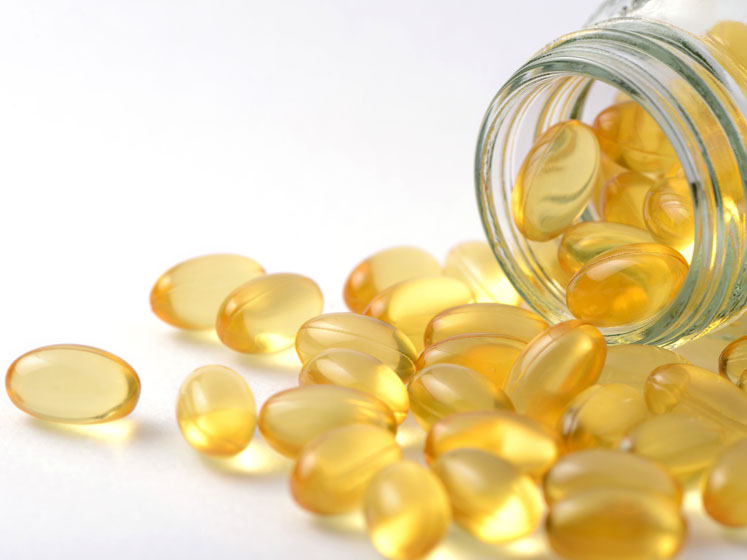Omega-3 fatty acids are among the most studied nutrients and have been associated with numerous health benefits, reports Dr Bente J. Foss, Chief Technology Officer at
GC Rieber VivoMega.
EPA and DHA are only found in seafood and, especially, in oily fish. As the formation of EPA and DHA is limited in humans, we must rely primarily on dietary sources to get sufficient levels of omega-3s.1
Physiological functions in humans
Highly unsaturated long-chain fatty acids such as EPA and DHA have two critical physiological functions in humans.
First, as an integral part of the phospholipids in cell membranes, they contribute to an optimal membrane structure that allows intercellular communication and vital functions.
Second, as primary precursors of bioactive lipid mediators, including the eicosanoids, they are indirectly involved in cell signalling processes inside the cell and between other cells.
Through these physiological functions, omega-3 fatty acids exert anti-inflammatory and immune-modulating actions that may positively impact our health.2,3
The connection between omega-3s and bone and joint health
Our bodies consist of 206 bones and the joints form the connections between those bones. Any damage to the bones and joints from disease or injury can cause pain and, even worse, negatively impact our mobility.
Bones and joints are maintained by complex physiological mechanisms in which nutrients such as EPA and DHA serve a role.4,5

Research has shown that by impacting bone metabolism, EPA, DHA and other lipid biomolecules derived from them may reduce the risk of bone fracture and decrease bone loss.4,6 Studies have also shown that EPA/DHA’s ability to dampen inflammation may help reduce joint pain and stiffness.7,8
Omega-3s for bone and joint conditions
Osteoarthritis (OA) is a degenerative joint condition in which the cartilage within a joint begins to break down and the underlying bone begins to change. The main symptoms of OA are pain and stiffness in the joints.9
A study from 2012 looked at the association between plasma levels of fatty acids and synovial inflammation in patients who had or were at risk of knee OA. In this study, it was found that patients with high levels of plasma omega-3s, specifically DHA, had lower cartilage loss in the knee joint compared with a placebo.10
A recent meta-analysis covering nine randomised clinical trials and 2070 patients with OA showed that daily EPA and DHA supplementation significantly relieved arthritis pain when compared with a placebo and was also associated with improved joint function in these individuals.
Interestingly, the observed improvement in arthritis pain was better in patients younger than 65 than in those older than 65.11
Rheumatoid arthritis (RA) is a chronic inflammatory disorder that first affects your joints but can also affect other body systems.
Epidemiological studies have shown that dietary intakes that are low in omega-3s increase the risk of developing rheumatoid arthritis; further, it has been reported that diets including weekly fish consumption have resulted in significantly lower pain in patients with RA than ordinary diets.12,13
Supporting these findings, several clinical trials have shown that omega-3 fatty acid supplementation may reduce the number of tender joints, early morning stiffness and pain levels in RA patients.14
Owing to a condition known as osteoporosis, our bones weaken as we age. It is estimated that 50% of women and 25% of men older than 50 experience bone fractures associated with this condition.15
A higher fish/seafood intake and more concentrated omega-3 blood levels have been associated with protection against bone loss and osteoporosis in older men and postmenopausal women.4,6
Clinical studies indicate that supplementation with EPA and DHA may help to improve bone strength and, consequently, fractures by increasing calcium absorption, bone calcium content and bone mass in humans.4
The beneficial mechanisms behind omega-3s
Bone metabolism is a lifelong cycle of growth and resorption, and also controls the formation of bones after fractures or damage from normal activity. Our bones get more fragile as we age because of increased activation of the inflammatory signalling pathways, which negatively impact bone metabolism.
Studies have indicated that EPA and DHA regulate bone metabolism by reducing the release of lipid mediator prostaglandin E32 (which is involved in regulating both bone formation and resorption), interacting with osteoclast receptors (cells that cause bone resorption), modulating inflammatory cytokines, increasing calcium levels in the bones and by reducing oxidative stress, which is also linked to bone resorption.4
Joint pain is often caused by inflammation in the joints and is not only common in conditions such as rheumatoid arthritis and osteoarthritis, but also in healthy athletic people in relation to sports and repeated mechanical stress.16
Many experimental studies have shown that EPA and DHA can modulate inflammation by reducing the levels of inflammatory components, such as certain cytokines.9 Their mode of action in relieving joint pain has also been associated with improving microvascular functions and reducing oxidative stress.17

Ensuring proper omega-3 intake
EPA and DHA are only found in seafood and, in particular, fatty fish such as mackerel and herring. EPA and DHA are formed in the human body by the conversion of alpha-linolenic acid (ALA: 18:3 n-3), but the extent of this conversion is small.1
Therefore, supplementing with marine sources will provide most of the EPA and DHA needed for our blood and tissues for improved well-being.
Recommendations from authoritative and regulatory bodies worldwide are typically 1–2 servings of fish per week, which is equal to 200–500 mg of EPA + DHA per day.
The European Food Safety Authority (EFSA) recommends a daily intake of EPA + DHA for several health outcomes, and combined doses of EPA + DHA up to approximately 5 g/day are generally considered to be safe.18,19
So, unless your diet is rich in fish, increasing your intake of omega-3s through dietary supplementation can be beneficial for your overall health and well-being, including your bones and joints.
References
- P.C. Calder, “Very Long-Chain n-3 Fatty Acids and Human Health: Fact, Fiction and the Future,” Proc. Nutr. Soc. 77(1), 52–72 (2018).
- P.C. Calder, “Mechanisms of Action of (n-3) Fatty Acids,” J. Nutr. 142(3), 592S–599S (2012).
- P.C. Calder, “n-3 Fatty Acids, Inflammation and Immunity: New Mechanisms to Explain Old Actions,” Proc. Nutr. Soc. 72(3), 326–336 (2013).
- N. Kajarabille, et al., “A New Insight to Bone Turnover: Role of ω-3 Polyunsaturated Fatty Acids,” Scientific World Journal (2013): DOI: 10.1155/2013/589641.
- S. Thomas, et al., “What is the Evidence for a Role for Diet and Nutrition in Osteoarthritis?” Rheumatology (Oxford) 57(Suppl. 4), iv61–iv74 (2018).
- E. Choi and Y. Park, “The Association between the Consumption of Fish/Shellfish and the Risk of Osteoporosis in Men and Postmenopausal Women Aged 50 Years or Older,” Nutrients 8(3), 113 (2016).
- R.J. Goldberg and J. Katz, “A Meta-Analysis of the Analgesic Effects of Omega-3 Polyunsaturated Fatty Acid Supplementation for Inflammatory Joint Pain,” Pain 129(1), 210–223 (2007).
- I. Kostoglou-Athanassiou, et al., “The Effect of Omega-3 Fatty Acids on Rheumatoid Arthritis,” Mediterr. J. Rheumatol. 31(2), 190–194 (2020).
- D.M. Cordingley and S.M. Cornish, “Omega-3 Fatty Acids for the Management of Osteoarthritis: A Narrative Review,” Nutrients 14(16), 3362 (2022): DOI: 10.3390/nu14163362.
- K.R. Baker, “Association of Plasma n-6 and n-3 Polyunsaturated Fatty Acids with Synovitis in the Knee: The MOST Study,” Osteoarthritis Cartilage 20(5), 382–387 (2012).
- W. Deng, et al., “Effect of Omega-3 Polyunsaturated Fatty Acids Supplementation for Patients with Osteoarthritis: A Meta-Analysis,” J. Orthop. Surg. Res. 18(1), 381 (2023).
- D. Di Giuseppe, et al., “Fish Consumption and Risk of Rheumatoid Arthritis: A Dose-Response Meta-Analysis,” Arthritis Res. Ther. 16(5), 446 (2014).
- K.A. Schönenberger, et al., “Effect of Anti-Inflammatory Diets on Pain in Rheumatoid Arthritis: A Systematic Review and Meta-Analysis,” Nutrients 13(12), 4221 (2021).
- A. Gioxari, et al., “Intake of Omega-3 Polyunsaturated Fatty Acids in Patients with Rheumatoid Arthritis: A Systematic Review and Meta-Analysis, Nutrition 45, 114–124 (2018).
- H. Abou-Saleh, et al., “Bone Benefits of Fish Oil Supplementation Depend on its EPA and DHA Content,” Nutrients 11, 2701 (2019): DOI: 10.3390/nu11112701.
- M. Stupin, et al., “The Physiological Effect of n-3 Polyunsaturated Fatty Acids (n-3 PUFAs) Intake and Exercise on Hemorheology, Microvascular Function, and Physical Performance in Health and Cardiovascular Diseases; Is There an Interaction of Exercise and Dietary n-3 PUFA Intake?” Front. Physiol.10, 1129 (2019).
- J.C. Kuszewski, et al., “Fish Oil Supplementation Reduces Osteoarthritis-Specific Pain in Older Adults with Overweight/Obesity,” Rheumatology Advances in Practice 4(2), 1–9 (2020).
- www.efsa.europa.eu/en/efsajournal/pub/1461.
- www.efsa.europa.eu/en/efsajournal/pub/2815.
